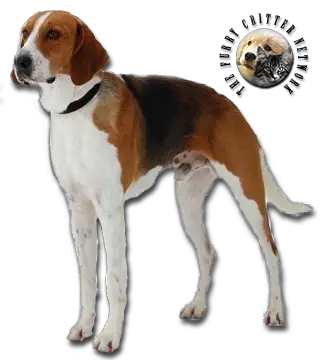Breed Standard
Head: Fairly long. Broad, slightly domed skull. Moderate stop. Straight, square muzzle.
Ears: Long, thin, fairly wide, hanging close to the head.
Eyes: Large, well-spaced. Brown or hazel.
Body: Long. Neck open, back without dewlap. Chest deep and narrower than in the English Foxhound. Well-sprung ribs.
Tail: Carried gaily, slightly curved but not hanging over the back. Slight brush.
Hair: Medium in length, dense, harsh.
Coat: All colors are tolerated.
Size: Dog: 56 to 64 cm (22-25 in).Bitch: 53.3 to 61 cm (21-24 in).
Weight: Approx. 30 kg (66 lb).
History
English Foxhounds were imported to the United States around 1650 by the British breeder R. Brooke. The breed was crossed with English, French, and Irish hounds. American Foxhounds, probably the oldest American hounds, come in many varieties and hunt foxes and large game. Recognized by the American Kennel Club in 1894, the breed is not very common.
Behavior
The American Foxhound is a very sweet, loving, affectionate, and kind breed. However, when it comes to the hunt they are brave and daring. They get along very well with children and love their human families dearly. However, they do tend not to like any other animals besides dogs, the pact instinct. The American Foxhound will be perfectly content with all kinds of other dogs but may be a bit aggressive with other pets you may have.
The American Foxhound is normally very friendly even with strangers however; some may also be very protective over family members.
The American Foxhound is not recommended to live indoors especially in apartments. He is an outdoor breed that loves hunting anything when he gets a whiff of their scent. Even outdoors, he can be quite hard to handle if he smells a deer, a squirrel, or in some cases a cat. He will do everything in his power to find the prey. They are not dumb, a matter of fact they are very intelligent and can jump over high fences and even unlock gates when on a hunt. Leaving an American Foxhound indoors can be a huge mistake as they become bored quickly and then will become very mischievous. He will need a large area to romp and play.
Function
The American Foxhound is still primarily a hunting and field trial dog in both packs and alone, though he has also had success as a companion dog for those owners who provide enough exercise and activities. Its talents are hunting, tracking, watchdog and agility. The American Foxhound is somewhat faster and a little leaner than the English Foxhound.
Health
American Foxhounds do have a tendency to overeat if the food is accessible, be sure not to overfeed, as they will become overweight.






